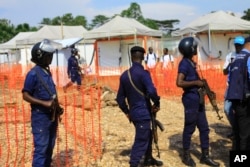With the Democratic Republic of Congo facing its second major Ebola outbreak this year, emergency responders have worked to contain the spread of the disease. Scientists, meanwhile, are testing the effectiveness of experimental vaccines in the field.
Alongside these efforts, researchers in the DRC are collecting data that will improve how we respond to, and prevent, future outbreaks of Ebola and other infectious diseases.
Their work involves building a comprehensive picture of how diseases like Ebola spread by tracking cases and mapping where people live, work and seek health care.
Over time, a more sophisticated understanding of the environments through which contagious diseases spread will lead to faster, more effective treatment.
Long-term response efforts
Anne Rimoin is an associate professor of epidemiology at the UCLA School of Public Health. She’s also the director of the UCLA-DRC Health Research and Training Program, an effort based in Kinshasa, Congo, that’s been underway for 16 years.
Rimoin returned to the U.S. last month from fieldwork in the DRC. She told VOA that her group is collecting data that will benefit responses to not just Ebola but also emerging infectious diseases.
“In an outbreak, you have to understand where people are and what their patterns of travel are. Where they’re going, where they’re working, where their fields are,” Rimoin said. “If you don’t know where things are, it becomes very difficult to define a response.”
Collecting this kind of data is especially important in a country like Congo, where small, unmapped villages checker vast forests, and the infrastructure hasn’t, for the most part, been developed.
“The DRC is a very large country,” Rimoin said. “There haven’t been good, accurate maps of the DRC available to date.”
High-tech and local knowledge
Rimoin’s group partners with several organizations, including the DRC’s Ministry of Health, the World Health Organization and the Centers for Disease Control and Prevention, part of the U.S. Department of Health and Human Services.
Rimoin said the Health Research and Training Program in Kinshasa uses a mix of high-tech solutions and local knowledge. The group analyzes satellite imagery to understand the terrain and population centers in the DRC. But they also rely on insights from residents to compile a more accurate and complete data set.
These data-collection tools allow Rimoin’s team to figure out not just boundaries but human activities, including traffic flows and health centers.
They plot important landmarks like roads, rivers and health centers. They also track exposure to health care workers and people who have been vaccinated to compare them to other populations, building a more complete understanding of how prevention drugs work.
“It’s important for data to be available so that you can look for trends between outbreaks and try to find commonalities and try to be able to quickly ascertain similarities between outbreaks,” Rimoin said.
Local knowledge
Working with local populations is critical to the project’s success. It’s these experts who know the terrain and the population, and that expertise often proves invaluable, especially when faced with skepticism from residents about the efficacy of vaccines.
By partnering with local organizations and international efforts with a long-term commitment to the country, Rimoin said, the Health Research and Training Program is better positioned to work with communities to understand their needs, concerns and beliefs.
“It’s really important to work with people who are there all the time — not parachuting in,” Rimoin said.









